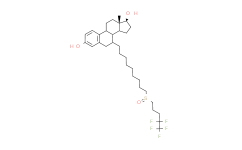| Cas No.: | 129453-61-8 |
| Chemical Name: | Fulvestrant |
| Synonyms: | Fulvestrant;(7a,17b)-7-[9-[(4,4,5,5,5-pentafluoropentyl)sulfinyl]nonyl]estra-1,3,5(10)-triene-3,17-diol;Fulvestrant (ICI 182780,ZD 9238, Faslodex®);Fulvestrant Solution;ICI 182,780;(7R,8R,9S,13S,14S,17S)-13-methyl-7-[9-(4,4,5,5,5-pentafluoropentylsulfinyl)nonyl]-6,7,8,9,11,12,14,15,16,17-decahydrocyclopenta[a]phenanthrene-3,17-diol;Bendamustine hydrochloride;EP3101;Faslodex;SDX105;ZD 182780;ZD9238;ZM182780;Fulvtrant;ICH-182780;Fulvstrant;ICI-187280;Fulvestran;ZD 9238;zd182780 |
| SMILES: | C[C@@]12[C@@H](O)CC[C@@]1([H])[C@]3([H])[C@H](CCCCCCCCCS(CCCC(F)(F)C(F)(F)F)=O)CC4=C(C=CC(O)=C4)[C@@]3([H])CC2 |
| Formula: | C32H47F5O3S |
| M.Wt: | 606.77080655098 |
| Sotrage: | 2 years -20°C Powder, 2 weeks 4°C in DMSO, 6 months -80°C in DMSO |
| Description: | Fulvestrant is a potent Estrogen Receptor antagonist with an IC50 of 9.4 nM. |
| In Vivo: | When administered alone, parenterally (s.c.), to immature female rats Fulvestrant (ICI 182,780) is devoid of uterotropic activity and, when coadministered with Estradiol, it effectively blocks the uterotropic action of Estradiol in a dose-dependent manner (ED50: 0.06 mg/kg/day s.c.). Complete antagonism of Estrogen action is achieved with a dose of 0.5 mg Fulvestrant/kg/day s.c. The effects of Fulvestrant administered p.o. are qualitatively similar but potency is reduced by an order of magnitude compare with s.c. dosing (ED50 0.46 and complete antagonism at 5 mg/kg/day p.o.)[1]. The antitumour activity of Fulvestrant is first demonstrated in two models of human breast cancer in nude mice. In one of these models, the growth of MCF-7 tumour xenografts, supported by continuous treatment with oestradiol, is completely blocked for at least 4 weeks following a single injection of Fulvestrant 5 mg. Similar reductions in growth are seen in the Br10 human tumour model. In other studies in nude mice bearing MCF-7 xenografts, Fulvestrant suppresses the growth of established tumours for twice as long and tumour growth is delayed to a greater extent than is observed with Tamoxifen treatment. Tamoxifen-resistant breast tumours, which grow in nude mice after long-term treatment with Tamoxifen, remain ensitive to growth inhibition by Fulvestrant[2]. These are comparable to the tumor growth inhibition (TGI) observed for Tamoxifen and Fulvestrant, which on day 40 are 86 and 88%, respectively[3]. |
| In Vitro: | Fulvestrant (ICI 182,780) is a potent and specific inhibitor of estrogen action and demonstrates excellent growth-inhibitory effects in both cell and animal models of human breast cancer. Fulvestrant inhibits MCF-7 human breast cancer cells growth with IC50 of 290 nM. The relative binding affinities of Fulvestrant is 0.89 compare with that of Estradiol. Fulvestrant has significantly increased antiestrogenic potency and retains pure estrogen antagonist activity[1]. Fulvestrant is the first of a new type of endocrine treatment-an oestrogen receptor (ER) antagonist that downregulates the ER[2]. Treatment of MCF-7 cells with 1 µM Tamoxifen has no effect on the expression of ERα, whereas 100 nM Fulvestrant completely inhibits ERα expression[3]. |






















